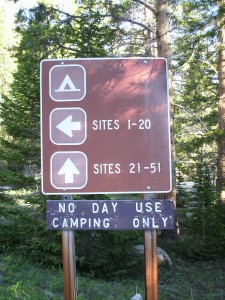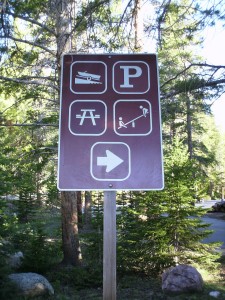Afraid of making a mistake or not planning the perfect vacation because you don’t know where to go or what to do when you get to the park? If so, then keep reading. Whether you are going for the day or staying over night, this post covers what facilities are available in many parks in addition to the signs you might encounter and what they mean. Let’s get started.
Entering a Park
 Entering a park could occur at a ranger station, or, in the case of a national forest location you will see the welcome sign like the one in the following photo.
Entering a park could occur at a ranger station, or, in the case of a national forest location you will see the welcome sign like the one in the following photo.
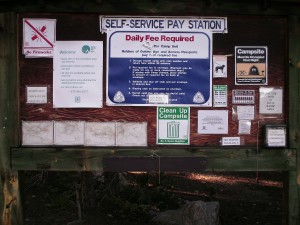 After passing the entrance sign you may come across this national forest service sign which is an information board telling you about the campground.
After passing the entrance sign you may come across this national forest service sign which is an information board telling you about the campground.
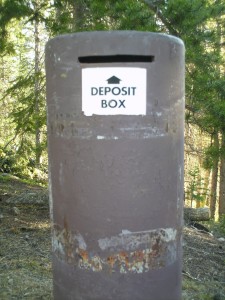 If the above photo is also a pay station, then where do you pay? You pay here at the drop box which in this case is a hollow metal post. Remember, if you did not make a reservation ahead of time, you will need to have the exact amount of cash to pay for your campsite. You will put this cash in an envelope and insert it into the drop box. Also, there is no one available to make change or take credit cards at most national forest campgrounds. Plan ahead!
If the above photo is also a pay station, then where do you pay? You pay here at the drop box which in this case is a hollow metal post. Remember, if you did not make a reservation ahead of time, you will need to have the exact amount of cash to pay for your campsite. You will put this cash in an envelope and insert it into the drop box. Also, there is no one available to make change or take credit cards at most national forest campgrounds. Plan ahead!
Which Way to Go?
The following two photos show signs that help you find your way in the park.
Campground Area
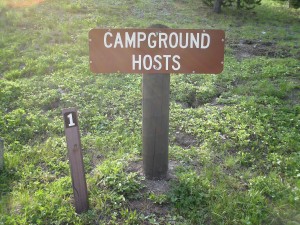 When you get to the campsite area the first sign you are likely to see is for the campground host. The campground host is the person or couple that lives in their recreational vehicle or RV right there in the park. Their main jobs are to make sure that campers have paid for their campsite, to call authorities when a camper needs help and to answer basic questions about the park.
When you get to the campsite area the first sign you are likely to see is for the campground host. The campground host is the person or couple that lives in their recreational vehicle or RV right there in the park. Their main jobs are to make sure that campers have paid for their campsite, to call authorities when a camper needs help and to answer basic questions about the park.
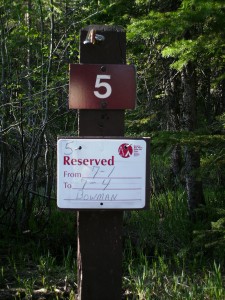 The next signs you will see are numbered posts or boards. These are the campsites. If you made a camping reservation, your campsite will be reserved for you as seen in this photo.
The next signs you will see are numbered posts or boards. These are the campsites. If you made a camping reservation, your campsite will be reserved for you as seen in this photo.
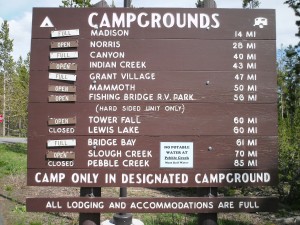 If you did not make a reservation, your job will be to drive through the campground and select the site where you want to stay. Remember, not to choose a campsite that is already reserved for that night. At this point, you will drive back to the information board or ranger station and pay for your site by either placing money into a payment box or giving money to a park employee. To assist you in finding a camping spot in some of the big parks, occupancy signs have been erected to help make your search faster.
If you did not make a reservation, your job will be to drive through the campground and select the site where you want to stay. Remember, not to choose a campsite that is already reserved for that night. At this point, you will drive back to the information board or ranger station and pay for your site by either placing money into a payment box or giving money to a park employee. To assist you in finding a camping spot in some of the big parks, occupancy signs have been erected to help make your search faster.
A Typical Campsite
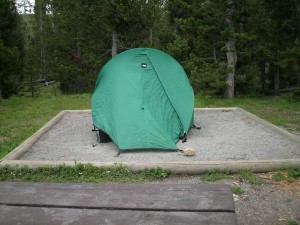 Most campsites in developed campgrounds have tent pads. This is the place where you set up your tent for the night. The purpose of the tent pad is to contain the people’s camping impact to one area thus preventing the grass from dying and then the soil washing away during the next rain.
Most campsites in developed campgrounds have tent pads. This is the place where you set up your tent for the night. The purpose of the tent pad is to contain the people’s camping impact to one area thus preventing the grass from dying and then the soil washing away during the next rain.
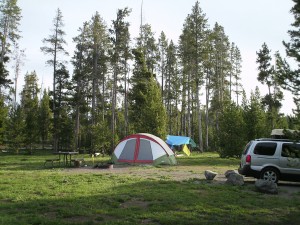 Near but not too close to the tent pad is the fire ring. This is where you will build a campfire should that be in your plans.
Near but not too close to the tent pad is the fire ring. This is where you will build a campfire should that be in your plans.
Also at your campsite will be a picnic table. Most but not all are bolted to a cement pad or the ground so they don’t get moved all over the campground. If you are going be eating in a large group, you might consider bringing a folding table and chairs if more than eight people will be eating together.
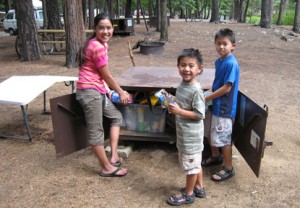 In places where bears live, the parks typically provide a bear box where you are to store your food. Use this box or you will be setting the bears up to be shot because you contributed to them becoming a problem. When a bear box is available, do not store your food in the car because bears have a great sense of smell and will break into your car for a yummy treat. This photograph is courtesy of the National Park Service.
In places where bears live, the parks typically provide a bear box where you are to store your food. Use this box or you will be setting the bears up to be shot because you contributed to them becoming a problem. When a bear box is available, do not store your food in the car because bears have a great sense of smell and will break into your car for a yummy treat. This photograph is courtesy of the National Park Service.
Bathrooms, Showers and Drinking Water
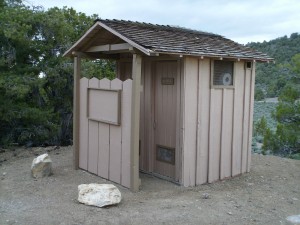 If you pay a fee to enter a park, it will most likely have some type of bathroom. In a national forest, the bathroom is usually a pit toilet as seen in the first picture. I recommend bringing your own toilet paper because sometimes the person before you took all of the toilet paper with them, and, if you are using it at night you will need to bring your own source of light.
If you pay a fee to enter a park, it will most likely have some type of bathroom. In a national forest, the bathroom is usually a pit toilet as seen in the first picture. I recommend bringing your own toilet paper because sometimes the person before you took all of the toilet paper with them, and, if you are using it at night you will need to bring your own source of light.
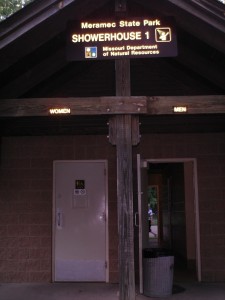 In this photo, you see a bathroom that is more typical of a national or state park. Here you will usually have running water and electricity so you can see what you are doing. At night you will still want to bring a light source so you can navigate your way back to your campsite.
In this photo, you see a bathroom that is more typical of a national or state park. Here you will usually have running water and electricity so you can see what you are doing. At night you will still want to bring a light source so you can navigate your way back to your campsite.
Many state campgrounds and some national parks offer showers at their bathroom facilities which is nice if you are going to be on the road for several days.
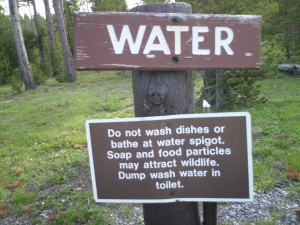 Next to many campsites or near most bathrooms is the water station. This is where you come to fill up your water jug for cooking and drinking. Notice in the following photo that you should not clean your dishes or fish in this area because it attracts animals and insects. This is a shared water source. Respect the other campers.
Next to many campsites or near most bathrooms is the water station. This is where you come to fill up your water jug for cooking and drinking. Notice in the following photo that you should not clean your dishes or fish in this area because it attracts animals and insects. This is a shared water source. Respect the other campers.
Safety Signs
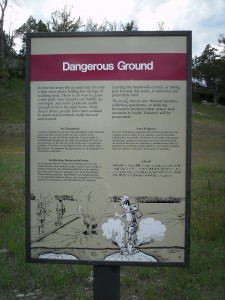 In many parks, there are few if any physical barriers such as railings or walls that separate you from an attraction such as a waterfall, geyser field or canyon cliff. Instead, the parks post signs warning you of specific dangers. This helps make your experience safer, look less city like and help preserve the park in its natural state. Please obey these signs. Many people have been hurt or lost their lives because they thought the signs did not apply to them because they thought they had special accident avoiding powers.
In many parks, there are few if any physical barriers such as railings or walls that separate you from an attraction such as a waterfall, geyser field or canyon cliff. Instead, the parks post signs warning you of specific dangers. This helps make your experience safer, look less city like and help preserve the park in its natural state. Please obey these signs. Many people have been hurt or lost their lives because they thought the signs did not apply to them because they thought they had special accident avoiding powers.
Trail Signs
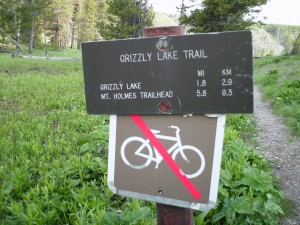 Most trails have signs indicating what direction to go and the distance you have to walk to reach your destination. In areas where erecting a sign would damage the landscape or if there is no good way to erect a sign then a pile of rocks also called a cairn is used to indicate the trail.
Most trails have signs indicating what direction to go and the distance you have to walk to reach your destination. In areas where erecting a sign would damage the landscape or if there is no good way to erect a sign then a pile of rocks also called a cairn is used to indicate the trail.
